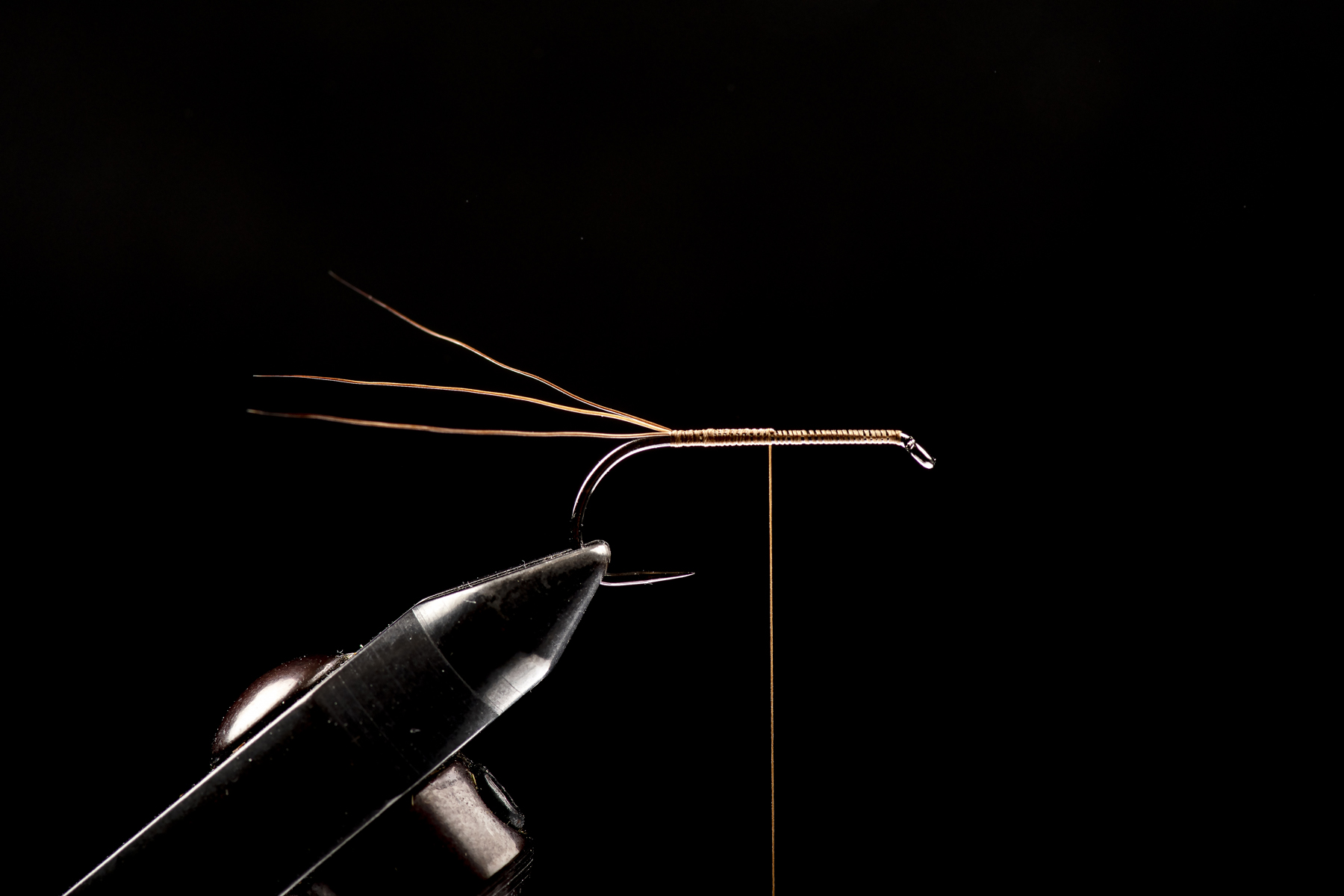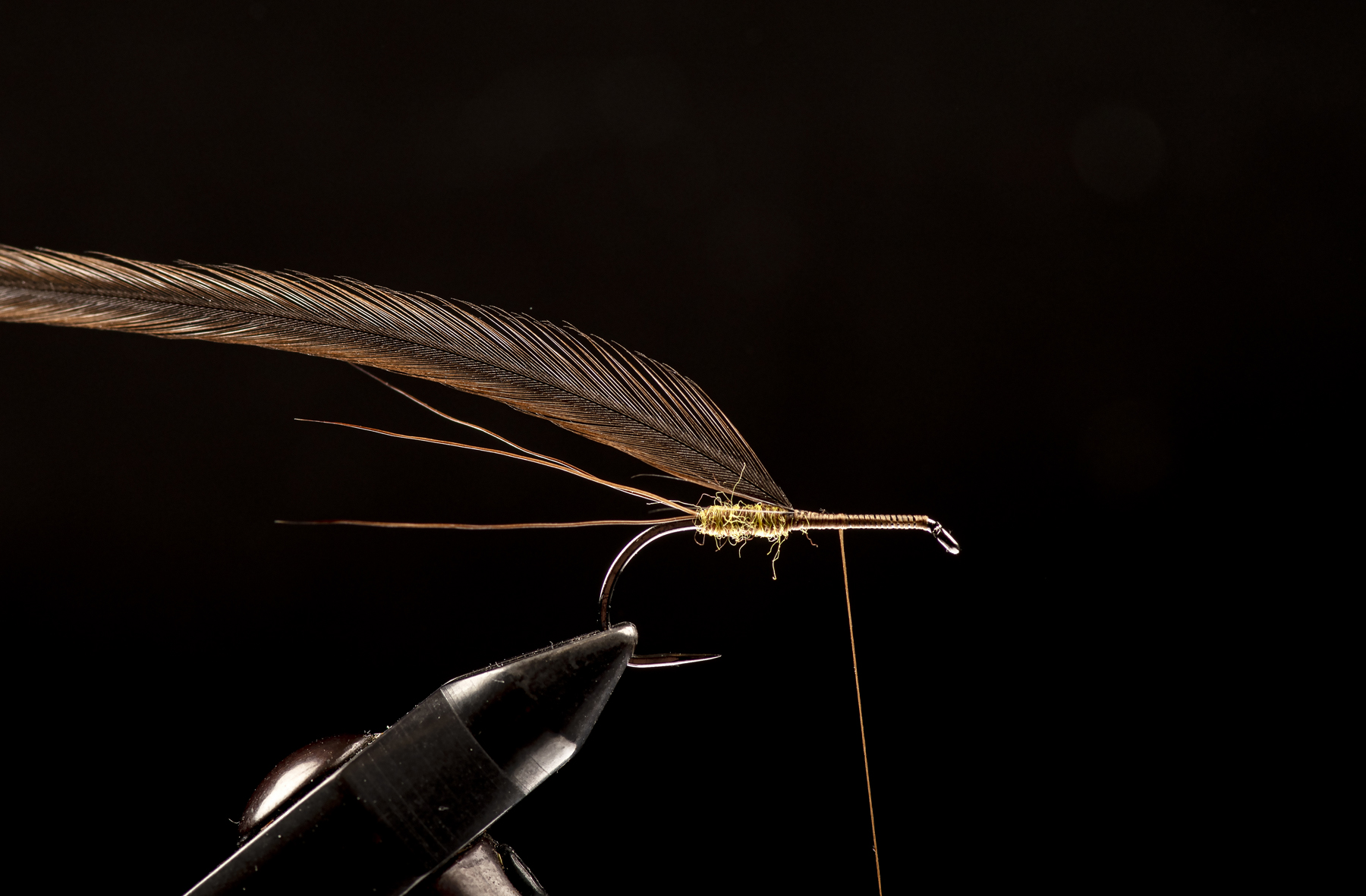
7 minute read
Fly Tying: THE DREAM OF MAYFLY HATCHES
The hatching of large mayflies, Ephemera danica, is often considered the highlight of the Danish brown trout fishing season. Experienced dry fly angler John Petermann shares a few basic tips and introduces three favorite flies that he always keeps in his early summer fly box—along with one wildcard.
By PETER LYNGBY

The Dream of Mayfly Hatches
The dream of hitting one of the year’s first big mayfly hatches lives in every fly fisher’s heart. Days when the majestic insects fill the air, and the river’s brown trout frenzy in a feeding spree— even the largest and wariest fish abandon caution and join the feast.
However, there are also days when fishing is challenging, or the anticipated mayfly hatch fails to occur. What should a beginner do in these situations? How do you plan for optimal conditions, and what if the fish turn their attention to other food sources?
To answer these questions, we turned to John Petermann, an experienced dry fly angler who has fished Danish mayfly seasons for over three decades. Petermann is a walking encyclopedia of entomology, the study of insects, and his enthusiasm for their Latin names and life stages is infectious. He is also deeply passionate about fly tying and the many ways to imitate insects. In this article, however, we focus on the basics of mayfly fishing and some simple yet reliable flies for the season.

Timing and Hatches
The key to successful mayfly fishing is timing the hatches, and Petermann shares his insights on when and where to go.
“Most of my mayfly fishing takes place at the Kongeåen and Gudenåen rivers, which have the largest populations of mayflies. Both rivers have angling associations offering memberships or day passes. The mayfly season typically runs from mid-May to mid-June. The best fishing occurs during the first solid hatches in May, although the largest swarms usually appear in June.
“Early in the season, fish are less selective and readily take mayflies. Later on, they can become more cautious and picky. If I had to choose just one trip, I’d plan it for the last week of May.
“That said, finding mayfly hatches isn’t particularly difficult. Warm days with an approaching low-pressure system are ideal. Look for those days when thunderclouds roll in, the sky turns purple, and the air becomes calm and humid.

Modified French Partridge (John Petermann’s Version)Hook: Ahrex FW571, size 4–8 (primarily size 6)Thread: Veevus 10/0, brownTail: Elk mane, naturalBody: Fly-Rite, brown drake yellow no. 34Body Hackle: Rooster feather, dark dunWing Hackle: Swiss CDC Ultra Select XL, dark grey khakiFront Hackle: French partridge feather, natural
This ‘calm before the storm’ is excellent mayfly weather, and hatches often explode on such evenings.
“While sunny days can be pleasant, insect activity usually slows, and the fish are much warier in bright sunlight,” warns Petermann.

Modified French Partridge
The largest mayflies have wingspans of nearly five centimeters, requiring a substantial dry fly to imitate them. However, Petermann notes that less can often be more.
“Many beautiful, intricate mayfly patterns have been tied over the years. When imitating the largest mayflies—the females—you often see extended body designs. My recommended fly, a heavily modified version of the French Partridge, is simpler. It imitates the smaller, more brownish males and has several advantages: it’s easier to tie, casts better, and hooks fish more effectively.
“For large brown trout, it’s easy to inhale a massive insect or imitation. However, not all trout are that size. I’ve found that extended-body flies often make hooking fish more difficult.
“My fly can be fished as a dun (floating on the surface) or a spinner (lying in the surface film). If needed, I trim the underside to create the spinner profile. It’s an all-around mayfly imitation, even though it has diverged significantly from the traditional French Partridge pattern. I replaced the classic yellow floss with a body hackle and added CDC to the wing for better floatation and movement.
“I regularly vary its size and color to match both males and females,” Petermann explains.

When Mayflies Fail
The mayfly season from mid-May to mid-June isn’t a continuous feast, so anglers should be prepared for other scenarios.
“Don’t forget the other insects during the mayfly season. Fish can switch to alternative food sources depending on hatches, which may vary along the river due to temperature differences. Smaller mayflies are abundant, and trout can be surprisingly selective.
“My CDC Upright Spinner imitates various mayfly species, including yellow ones, which are often less vibrant in their spinner stage.

A brown spinner can cover many egg-laying mayflies, but having a few small yellow ones in your box ensures readiness. I add a few white Fluoro Fibre strands to the CDC wing to mimic the reflective quality of insect wings in the light—just a few, though, as too many wings can look unnatural.
“Another must-have is my Floating Universal Nymph, which works well when trout bulge just below the surface. In the evening, they’re likely feeding on spinners; during the day, it’s often nymphs near the surface. This versatile pattern imitates several mayfly species and can be fished on or just below the surface.
“Lastly, always carry a few hawthorn fly imitations. These can be game-changers when trout suddenly switch to explosive strikes. Hawthorn flies are poor fliers and often end up in the water, especially on windy days. I’ve experienced phenomenal fishing with them along the Kongeåen,” Petermann reveals.

Casting Big Mayflies
Casting large mayflies requires some adaptation, especially for beginners. Petermann recommends sturdy dry fly gear.
“For newcomers, I recommend a classic 9-foot rod in a 5-weight with a fly line that isn’t too short-headed, like the Scientific Anglers Amplitude Smooth Infinity. Large dry flies tend to twist the leader, particularly if the tippet is too thin. I use leaders with 0.18 mm tips.
“Try casting at an angle to the fish to avoid too much line drifting over it before the fly. Always aim for a dragfree drift. If the fish doesn’t take on the first cast, try again. If it still refuses, it might be spooked or you might need to change tactics.
“Watch the fish closely. If it stops feeding, stop fishing and give it a break. If the fish keeps feeding but ignores your fly, it’s time to switch patterns. Observing fish behavior is crucial for success.
“When everything aligns, mayfly fishing can be both thrilling and effective. Always handle brown trout with care, as they are precious. Use barbless hooks to make release faster and easier,” Petermann concludes.










